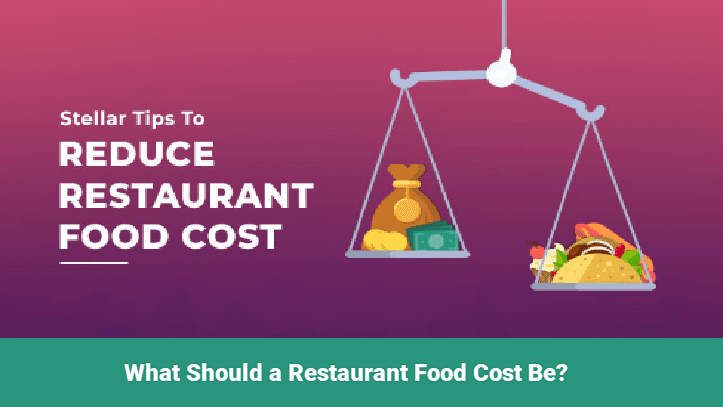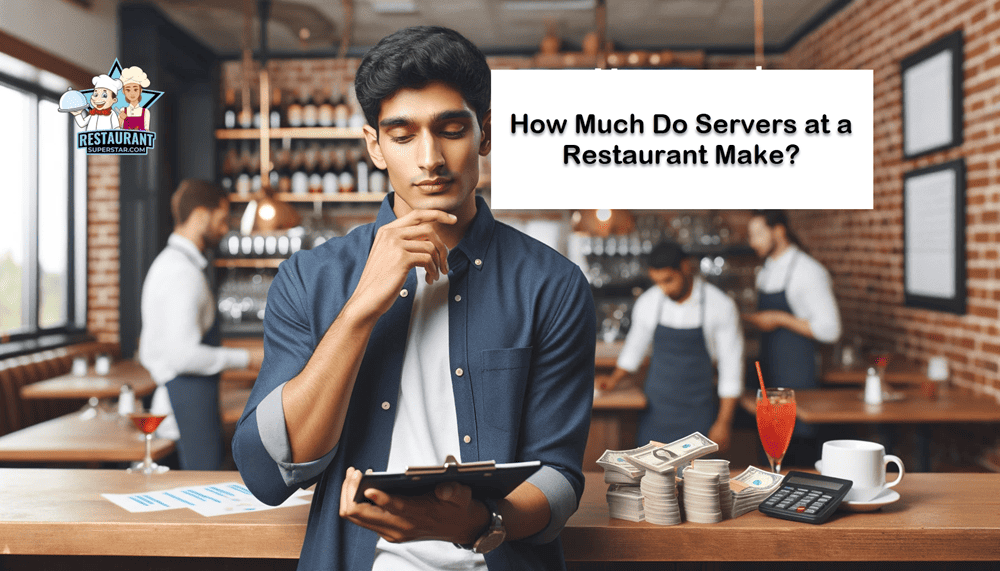What Should a Restaurant Food Cost Be? – 7 Tips

Hey there,
If you were wondering
What Should a Restaurant Food Cost Be?
You are in the right place.
I’m Jeff, a restaurant owner with years of experience, and I’m here to share some valuable insights with you. This blog post aims to provide in-depth details that you won’t need to look elsewhere for more information. So let’s dive in!
As a fellow restaurant owner, I understand that managing food costs is crucial for maintaining profitability and sustainability in this competitive industry. I’ve compiled this comprehensive guide on “What Should a Restaurant Food Cost Be.” This article will discuss everything from calculating food costs to optimizing inventory management.
What Should a Restaurant Food Cost Be
What Should a Restaurant Food Cost Be? A restaurant’s food cost should ideally be between 28-35% of the dish’s selling price. It can vary depending on factors like location, cuisine, and concept. Monitor ingredient costs, manage inventory efficiently, and optimize your menu to maintain a good food cost percentage.
1 – Understanding Restaurant Food Costs
Understanding Restaurant Food Costs is the first step towards mastering the financial aspect of running a successful restaurant. As a restaurant owner, you should be well-versed in the costs of preparing and serving each dish on your menu. Knowing the answer to “What Should a Restaurant Food Cost Be” can help you make informed decisions about menu pricing, portion control, and inventory management.
Food costs comprise the ingredients and raw materials used to create each dish, including proteins, produce, grains, and spices. Understanding these costs is crucial for striking the right balance between quality and affordability for your customers. Additionally, it enables you to gauge your kitchen’s efficiency, identify improvement areas, and spot potential cost-saving opportunities.
One key aspect of managing food costs is monitoring market prices for ingredients, which fluctuate significantly. By keeping an eye on market trends and adjusting your purchasing strategies accordingly, you can minimize the impact of price fluctuations on your bottom line. Moreover, understanding food costs helps you create a realistic budget, track expenses, and ensure your restaurant’s financial health.
Understanding restaurant food costs is essential for any restaurant Restaurant Owner seeking success in this competitive industry. By staying informed about “What Should a Restaurant Food Cost Be,” you’ll be better equipped to make data-driven decisions, optimize your operations, and ultimately achieve your financial goals.
2 – Calculating Your Food Cost Percentage
Calculating Your Food Cost Percentage is critical to understanding “What Should a Restaurant Food Cost Be.” The food cost percentage is the ratio of the cost of ingredients to the revenue generated from selling the dish. It’s a crucial metric that helps you assess your restaurant’s profitability and is relatively simple to calculate.
To determine your food cost percentage, you’ll need two primary figures: the cost of ingredients and the selling price of the dish. First, calculate the total cost of ingredients used to make a dish. This includes proteins and products, oils, spices, and other components. Next, divide the ingredient cost by the dish’s selling price, then multiply by 100 to get the percentage.
For example, if a dish costs $5 in ingredients and sells for $15, the food cost percentage would be (5 ÷ 15) × 100 = 33.33%. This means that 33.33% of the revenue generated from selling the dish goes towards covering the cost of ingredients.
Understanding your food cost percentage is vital for setting appropriate menu prices, maintaining profitability, and making informed decisions about cost-saving measures. Ideally, restaurants should aim for a food cost percentage between 28-35%, which can vary depending on location, cuisine type, and restaurant concept.
Calculating your food cost percentage is essential for restaurant owners to master. By accurately determining “What Should a Restaurant Food Cost Be,” you can optimize your menu pricing, improve your bottom line, and ensure your restaurant’s long-term success.
3 – Factors That Affect Food Costs
Understanding the Factors That Affect Food Costs is crucial for any restaurant owner who wants to answer the question, “What Should a Restaurant Food Cost Be?” Several factors can impact the cost of ingredients, and being aware of these factors can help you make informed decisions to keep your expenses in check. Let’s explore some of the most common factors influencing food costs.
Seasonality: The availability and price of fresh produce often vary according to the season. Sourcing ingredients when they are in season can lead to lower food costs and higher-quality dishes.
Market fluctuations: Global events, weather conditions, and changing supply and demand dynamics can affect the prices of various ingredients. Staying informed about market trends can help you make smarter purchasing decisions and minimize the impact of price fluctuations.
Supplier relationships: Building strong relationships with your suppliers can give you access to better deals, discounts, and even exclusive products, ultimately lowering food costs.
Waste management: Inventory and food waste can significantly increase food costs. Implementing effective waste reduction strategies, such as proper storage and portion control, can help mitigate this issue.
Menu design: The complexity and diversity of your menu can impact food costs. A smaller, more focused menu can lower ingredient costs and streamlined kitchen operations.
You can proactively manage your expenses by understanding the factors that affect food costs. This knowledge will help you make informed decisions and optimize your operations, ultimately helping you determine “What Should a Restaurant Food Cost Be” and ensuring your restaurant’s financial success.
4 – How to Lower Your Food Costs
As a restaurant owner, knowing How to Lower Your Food Costs is essential for maximizing profitability and answering the question, “What Should a Restaurant Food Cost Be?” Reducing food costs doesn’t mean compromising quality; it involves strategic planning and efficient practices. Here are some effective strategies to help lower your food costs:
Negotiate with suppliers: Develop strong relationships with your suppliers and negotiate better pricing or bulk discounts. This can help you secure favorable deals and reduce ingredient costs.
Implement portion control: Standardizing portion sizes ensures consistency and helps minimize waste and control food costs. Train your kitchen staff to adhere to standardized recipes and use proper measuring tools to maintain uniform portions.
Embrace seasonal ingredients: Utilize locally-sourced, seasonal ingredients to lower costs and offer fresh, flavorful dishes. Adjust your menu according to the season to take advantage of lower-priced, in-season produce.
Optimize inventory management: Regularly track inventory levels and use a first-in, first-out (FIFO) system to minimize spoilage and waste. Proper inventory management helps you make informed purchasing decisions and prevents overstocking or running out of ingredients.
Analyze menu performance:
- Regularly review your menu’s performance and identify low-performing items.
- Consider removing or adjusting dishes that aren’t selling well or have high food costs.
- Focus on offering popular, profitable options.
Minimize waste: Train your staff on waste reduction practices, such as repurposing ingredients, proper storage, and handling techniques. Reducing waste is not only cost-effective but also environmentally responsible.
Implementing these strategies can help you lower your food costs and contribute to the overall success of your restaurant. By focusing on efficiency and cost-effective practices, you’ll be better equipped to determine “What Should a Restaurant Food Cost Be” while maintaining quality and customer satisfaction.
5 – Inventory Management and Its Impact on Food Costs
Effective Inventory Management and Its Impact on Food Costs cannot be overstated when answering the question, “What Should a Restaurant Food Cost Be?” Proper inventory management allows you to optimize your restaurant’s operations, reduce waste, and ultimately, lower food costs. Here are some ways inventory management impacts food costs and how you can improve your processes:
Accurate forecasting: You can forecast future ingredient needs more accurately by tracking inventory levels and monitoring sales data. This helps you make informed purchasing decisions, preventing overstocking or running out of essential items.
Minimizing waste: Implementing a first-in, first-out (FIFO) system ensures that older ingredients are used before newer ones, reducing spoilage and waste. Regularly auditing your inventory helps identify potential waste areas and adjust your purchasing practices accordingly.
Supplier relationships: Effective inventory management helps you identify the most reliable and cost-effective suppliers. By consolidating orders and working with a select group of suppliers, you can negotiate better pricing and streamline the procurement process.
Theft prevention: Regular inventory checks can help deter employee theft by ensuring that discrepancies are quickly identified and addressed. This can have a direct impact on your food costs and overall profitability.
Menu optimization: Inventory management data can be used to analyze menu performance and identify high-cost or low-performing items. This information lets you adjust your menu to reduce food costs and boost profits.
You can significantly impact your restaurant’s food costs by implementing efficient inventory management practices. With a well-managed inventory, you’ll be better equipped to determine “What Should a Restaurant Food Cost Be” and maintain a profitable and sustainable business in the competitive restaurant industry.
6 – The Role of Menu Engineering in Food Cost Management
The Role of Menu Engineering in Food Cost Management is vital when determining “What Should a Restaurant Food Cost Be.” Menu engineering strategically designs and organizes your menu to enhance profitability, customer satisfaction, and overall dining experience. Here’s how menu engineering can impact food cost management:
Highlighting high-profit items: By analyzing food costs and sales data, you can identify the most profitable dishes on your menu. Menu engineering techniques, such as strategic placement and eye-catching design elements, can draw attention to these items and encourage customers to order them.
Balancing food costs: A well-engineered menu offers various dishes with varying food costs. This balance allows you to offset high-cost items with more profitable options, keeping overall food costs in check.
Streamlining kitchen operations: Menu engineering can lead to a more efficient kitchen by simplifying recipes and reducing the number of ingredients needed. This can help lower food costs and improve overall profitability.
Enhancing perceived value: Effective menu engineering can make your dishes appear more enticing and valuable to customers, allowing you to charge a higher price without sacrificing customer satisfaction. This can contribute to better food cost management by increasing revenue.
Regular menu updates: Continuously analyzing and updating your menu based on changing food costs, customer preferences, and seasonality ensures you’re offering the most profitable and appealing dishes at any given time.
Menu engineering plays a significant role in managing food costs and overall restaurant profitability. By strategically designing and optimizing your menu, you’ll be better equipped to determine “What Should a Restaurant Food Cost Be” while providing an exceptional dining experience for your customers.
7 – The Importance of Monitoring Your Food Costs
The Importance of Monitoring Your Food Costs cannot be overstated when seeking the answer to “What Should a Restaurant Food Cost Be?” Regularly tracking and analyzing your food costs is essential for maintaining profitability, identifying areas for improvement, and making informed decisions about your restaurant’s operations. Here’s why monitoring your food costs is so crucial:
Profitability: Keeping a close eye on food costs helps ensure that your pricing strategy is aligned with your desired profit margins. Regularly reviewing and adjusting your menu prices can maintain profitability even as ingredient costs fluctuate.
Cost control: Monitoring food costs allows you to identify potential issues, such as waste, theft, or supplier price increases. By addressing these issues promptly, you can keep your expenses in check and protect your bottom line.
Efficiency: Analyzing food costs can reveal inefficiencies in your kitchen, such as excessive waste, improper portioning, or outdated recipes. Identifying and addressing these areas can lead to cost savings and improved operational efficiency.
Informed decision-making: Regular food cost monitoring provides valuable data that can inform various aspects of your business, including menu design, inventory management, and supplier relationships. This data-driven approach ensures that your decisions are based on accurate and up-to-date information.
Benchmarking: Tracking food costs enables you to benchmark your performance against industry standards and competitors. This insight can help you identify areas where your restaurant excels or needs improvement, allowing you to stay competitive.
Monitoring your food costs is essential for the financial success of your restaurant. By staying informed and proactive, you’ll be better equipped to determine “What Should a Restaurant Food Cost Be” and maintain a profitable, sustainable business in the competitive restaurant industry.
Conclusion: What Should a Restaurant Food Cost Be
In conclusion, understanding “What Should a Restaurant Food Cost Be” is essential to running a successful restaurant business. You can optimize your operations and maintain a profitable business by delving into the various components of food cost management, such as calculating food cost percentages, managing inventory, and employing menu engineering strategies.
Monitoring your food costs and being aware of the factors that affect them allows you to make informed decisions, control expenses, and maximize profitability. Embracing effective inventory management practices, reducing waste, and forging solid relationships with suppliers are all crucial steps in managing food costs.
Menu engineering plays a significant role in controlling food costs and ensuring the financial success of your restaurant. By strategically designing your menu, you can highlight high-profit items, balance food costs, and enhance your customers’ dining experience.
Ultimately, continuous monitoring, analysis, and adaptation are the key to managing food costs. By regularly reviewing your restaurant’s performance and staying informed about industry trends and best practices, you’ll be better equipped to determine “What Should a Restaurant Food Cost Be” and ensure the long-term success of your business.
As a restaurant owner, staying proactive, informed, and flexible will allow you to navigate the ever-changing landscape of the food industry, providing your customers with exceptional dining experiences while maintaining a thriving and sustainable business.
Jeff Smith is a Restaurant Consultant with over 20 years of hospitality experience ranging from server to owner and general manager. He focuses on Restaurant POS technology as well as restaurant marketing. Check out our world-famous restaurant resources resources page for a comprehensive offering of hand-picked resources and tools to help your business. You can also check out some of our other restaurant business articles.


